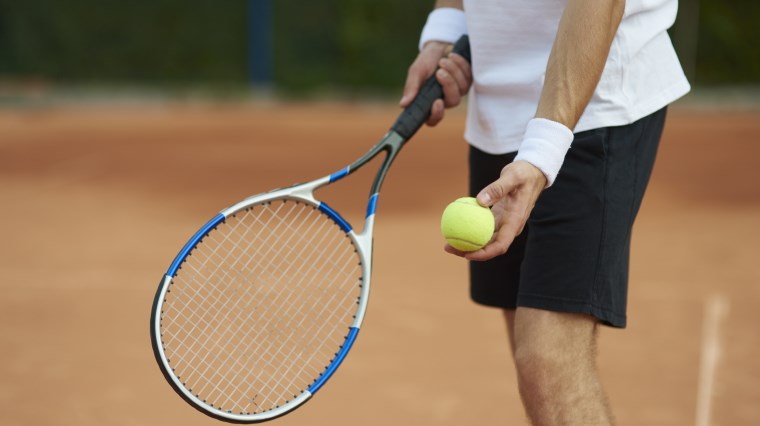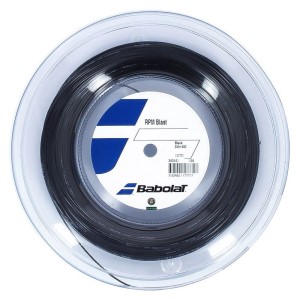What You Need To Know Before Buying Tennis Strings

Your tennis strings greatly influence your performance on the court and the playability of your tennis racquet as the part of the racquet that directly interacts with the ball. You may have heard the analogy that if your tennis racquet is a car, then your strings are its engine.
We’ll guide you through the most popular tennis racquet strings types and the player skill level they’re best suited for. We’ll also demystify how string tension, string gauge and string texture can impact your experience on the court.
String Type
Natural gut
Natural gut strings are often called the “king of all strings” with a long history on the court dating back to the 1800s, setting the bar for the performance and playability of synthetic strings. They’re made from intertwined ribbons crafted from the intestines of cows and accordingly, offer high elasticity that is difficult to replicate in synthetic materials – translating to more power.
The softness of natural gut improves ‘ball pocketing’ for an enhanced sensation of control and ensures an arm-friendly feel, even at higher tensions.
They provide a premium blend of comfort, feel and power and are less affordable than synthetic strings and therefore are most often seen in the hands of experienced players that want the very best in playability. The playability characteristics of natural gut also make them an asset for beginners, but in practice beginners may not be able to feel the benefits as readily as experienced players until they develop a better familiarity with different string types.
When kept in the right conditions (low humidity), natural gut is at the top of its game with excellent tension maintenance. A tennis racquet with natural gut string will feel as if it’s been freshly strung for the lifespan of the string, ensuring a consistent feel. As they are sensitive to humid conditions, natural gut strings are coated to improve weather resistance.
Natural gut isn’t susceptible to the ‘bagging out’ of synthetic strings, but in saying that they don’t match the durability of polyester strings and will break more frequently.
- High levels of power, comfort, feel
- Excellent playability, elasticity and tension maintenance
- Low durability
- Expensive
E.g. Luxilon Natural Gut 1.30 Tennis String
Multifilament (Nylon)
Softer and more flexible multifilament strings are the preference for beginners and intermediate players – with comfort second only to natural gut.
They are usually crafted from nylon and are made of hundreds of microfibers to offer excellent elasticity – with a goal to replicate that of natural gut. This makes them more arm-friendly than their polyester counterparts and an ideal choice for senior players and players susceptible to shoulder and elbow injuries like tennis elbow, as well as club and tournament players that prioritise comfort.
The trade-off is that like natural gut, they’re more prone to breakage from big hitters compared to firmer, more durable polyester strings. But of course, the lifespan of your strings is also influenced by your playing style and frequency of play.
Multifilament string is more powerful than monofilament polyester – meaning that in the hands of powerful players, it can be overkill and dramatically increase the risk of over-hitting. It offers user-friendly playability and resembles traditional natural gut string, at a more affordable price point. Although control is not one of their stronger characteristics, some multifilament strings are more control-oriented than others, like the Head Velocity MLT.
- All-rounder with good levels of power, comfort and feel
- Good playability, elasticity and tension maintenance
- Good affordability
- Lower levels of durability and control
E.g. Head Velocity MLT Tennis String and Head Reflex Tennis String
Monofilament (Polyester)
If you’re at an intermediate to advanced skill level and successfully generate your own power and pace, firmer polyester strings are ideal – catering to aggressive and fast-swinging playing styles.
Crafted from a single filament and encased in a thin coating, polyester strings are stiff – delivering the control and spin that players of experienced skill levels crave. They offer less elasticity than multifilament strings – translating to a shorter dwell times and a crisper, more consistent feel. They are also less arm-friendly – so arm strength is a must if you go in the monofilament direction.
Another potential trade-off compared to natural gut and multifilament strings is lower power – but this can be a benefit in the hands of strong, experienced players to avoid hitting the ball too deep. It’s important to get the level of power right for your skill level and playing style.
When you’re hitting for explosive spin, the durability of polyester means it can better tolerate the friction between strings. The high durability makes it a worthy option for string breakers and hard hitters, whereas injury-prone players may benefit from a softer string like multifilament.
When weighed up against multifilament strings, polyester springs back into shape more effectively and responsively when in good condition.
- High levels of control, spin and durability
- Lower levels of power, comfort, elasticity and tension maintenance
E.g. Babolat RPM Blast Tennis String and Luxilon 4G Tennis String
Hybrid
A blended or hybrid string pattern provides a middle ground for players that often experience breakage of softer strings yet prefer strings that are less firm than polyester.
The main strings dictate the feel of the tennis racquet – with its attributes dominating over the cross strings. The cross strings tweak this feel to personalise the string bed to your desired playing experience – customising the comfort, playability, durability, control and feel.
In a hybrid string pattern, the main strings that run vertically are often polyester, while the more forgiving cross strings are set up as a multifilament string to balance the firmness out with a softer feel.
Another hybrid set-up to consider is pairing natural gut with a co-polyester monofilament. This will offer the sought-out characteristics of natural gut while increasing its lifespan to meet the demands of string breakers and heavy topspinners. Keep in mind being a string breaker isn’t a negative – it’s a sign you’re loading the ball with pace and spin.
- Personalises your level of power, comfort, control, feel and durability
String Tension
String tension varies widely between tennis racquets, the preference of players and player skill level. Tennis racquets have a specific tension range recommended by the manufacturer.
Once you have a feel of the tennis racquet strung at a baseline tension, you can make minor adjustments to the tension - 2 - 3lbs higher or lower at a time to fine-tune the feel of the string bed.
As a guideline, for more control opt for a higher tension. For more depth or power, opt for a lower tension.
Natural gut and Multifilament (nylon): For softer, comfort strings like natural gut and nylon Wilson recommend a string tension of 50 - 60lbs (22.5 - 27kg) as a baseline. For these string types, they suggest a tension of 50 - 55lbs (22.5 - 25kg) to improve power and 56 - 60lbs (25.5 - 27kg) to improve control.
Monofilament (polyester): For a full bed of polyester string, the baseline tension range according to Wilson is 44 – 54lbs (20 – 24.5kg). It’s generally recommended to not be strung higher than 54lbs, as polyester string is naturally stiff and this may increase your risk of arm injury. A polyester string tension fine-tuned for power may be 44 – 49lbs (20-22kg) whereas the same string fine-tuned for control may be at a tension of 50-54lbs (22.5 – 24.5kg).
Hybrid (half and half): Wilson’s recommended tension range for a hybrid string pattern is 46 - 56lbs (21 – 25.5kg). For power 46 – 51lbs (21-23kg) is an acceptable range whereas the same string tuned for control may be at a tension of 52-56lbs (23.5 – 25.5kg). The polyester main string should be strung 2lbs lower than the chosen cross string due to its high stiffness.
String Gauge

The term string gauge refers to the thickness or the diameter of the strings and generally can be as low as 0.6mm or as high as 1.8mm.
There can be some variation with how tennis brands convert the mm diameter measurement of strings into a unit of gauge (generally 15 gauge being the thickest and up to 18 gauge being the thinnest), so to be safe it’s worth checking the mm measurements of the string on a brand’s packaging before purchase.
When weighing up different gauges of the same string side by side, the lower the gauge, the thicker the string and the higher the gauge, the thinner the string.
Thick gauge: Thicker strings are more durable with a longer lifespan, losing tension slower than thinner strings and deliver a greater degree of control.
Thin gauge: Thinner strings trade-off durability for improved playability – that is increased power, spin potential and feel. Being thinner, they deliver more grip or ‘bite’ on the ball, improving the ball’s interaction on the string bed, particularly when paired with spin-driven technique and racquet specs. Keep in mind that the friction that acts between strings where they cross will naturally cause them to wear out and ‘notch’ overtime.
The following is a guide based on Wilson’s gauge to string diameter (mm) conversion.
15/1.40mm: Thickest gauge with high degrees of control and durability to meet the demands of advanced heavy hitters.
16/1.30mm: Medium-thick gauge. Generally, it is recommended that string breakers choose a gauge of 1.30mm and up.
16L/1.28mm: Medium gauge for a balance of power and control.
17/1.25mm: Medium-thin gauge for power and comfort.
17L/1.20mm: Thin gauge for enhanced feel and touch.
18/1.15mm: Thinnest gauge for the highest degree of feel and touch.
Typically gauges 17, 16L and 16 are the most popular. The 'L' in 16L identifies the string as being 'light', meaning it’s fractionally thinner than the standard 16 gauge – a ‘half size’ between the 16 and 17. The same goes for other ‘L’ gauge types.
Choosing your string gauge should be based on personal preference – and depending on the other characteristics of the string, string gauge is generally not the deciding factor of whether a string is suitable for a beginner or advanced player.
When selecting string gauge, it’s important to look at the bigger picture as the string type will be a dominant factor that influences its performance.
It’s usually recommended beginners start off with a 16 or 17 gauge until they gain better familiarity of how this performs and then fine-tune their string choice further through trial and error.
String Texture and Shape
Smooth strings with a circular cross section are the traditional or standard string shape. With modern advances in string manufacturing, more textured polyester strings are making their way to the market.
Modern strings such as those with angular cross sections (e.g. octagonal), moulded grooves or other rough textures may offer increased spin potential – providing more ‘bite’ on the ball as it embeds into the string bed. This translates to more control, however it’s important not to rely solely on the string - there is no compromise for proper technique.
String Tips
- As a general guide, the number of times you use your tennis racquet on the court per week is the same as how often you should re-string the tennis racquet per year.
- Due to poor tension maintenance, polyester strings may need to be re-strung more frequently and a visual inspection can also reveal whether the string has been worn out (‘bagged out’) and therefore has degraded in the power, control or feel it offers.
- On your tennis journey, you may want to gradually transition between strings. For example, you may kick-off with an arm-friendly multifilament string, and then transition to a hybrid string before taking a full polyester string to the court.
- The way the individual characteristics of the string work together as a whole will define the performance of the string on the court and their longevity. For example, you may want to pair a multifilament string that is more susceptible to breaking with the thickest string gauge of that string type to boost durability.
Contact your coach for more guidance on the best string choices for your playing style and skill level. For more practical tennis content, read A Beginner's Guide To Tennis Racquet Specs and How To Choose The Best Tennis Racquet For Your Skill Level.

